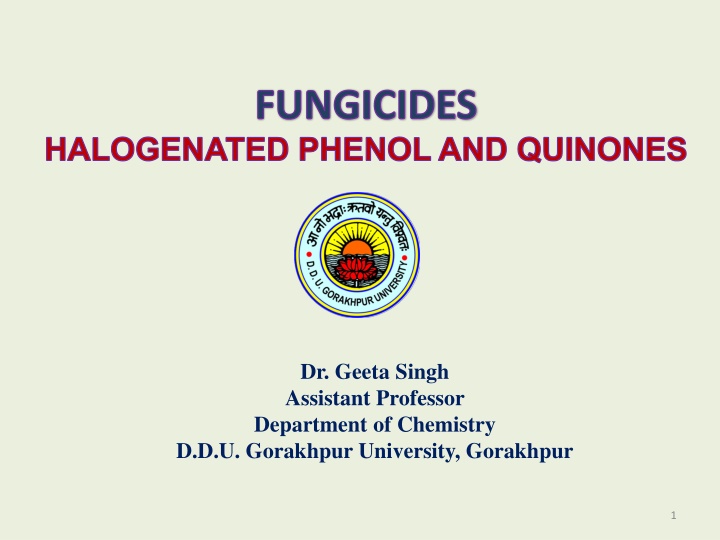
Halogenated Phenols: Properties and Uses in Fungicides
Discover the properties and uses of halogenated phenols in fungicides, including the preparation of pentachlorophenol and its toxicity. Learn about the importance of halogenated phenols in protecting materials from fungi and bacteria growth.
Download Presentation

Please find below an Image/Link to download the presentation.
The content on the website is provided AS IS for your information and personal use only. It may not be sold, licensed, or shared on other websites without obtaining consent from the author. If you encounter any issues during the download, it is possible that the publisher has removed the file from their server.
You are allowed to download the files provided on this website for personal or commercial use, subject to the condition that they are used lawfully. All files are the property of their respective owners.
The content on the website is provided AS IS for your information and personal use only. It may not be sold, licensed, or shared on other websites without obtaining consent from the author.
E N D
Presentation Transcript
FUNGICIDES HALOGENATED PHENOL AND QUINONES Dr. Geeta Singh Assistant Professor Department of Chemistry D.D.U. Gorakhpur University, Gorakhpur 1
Fungicides Fungicides are those compounds which are used to protect plants effected from fungi. Formaldehyde has been used as a potent fungicides for more than fifty years. Some organic compounds of mercury have also been used as commercial fungicides. Nowadays several organic compounds are being used a commercial fungicides which kill or check the metabolism of various species of the fungus.
Among potential fungicides the following three classes of compounds are very important. 1. Halogenated phenols 2. Halogenated quinones 3. Dithiocarbamate derivatives
Halogenated Phenols Phenols in general have high toxicity towards various species of fungi but the chlorinated phenols are widely used for treating wood and fabrics against molds and other fungi. The presence of one or more halogen atoms in the molecule has been found to increase the fungicidal properties. Therefore much attention has been devoted towards halogenated phenols and related compounds. Some of important compounds of this series are as follows:
Pentachlorophenol It is prepared by catalytic chlorination of phenol and sold as dark grayish flakes. solid m.p. 191 0C; decomposition temperature 310 0C. It is soluble in various organic solvents like acetone, benzene and many type of oils. Pure pentachlorophenol is a colourless crystalline
Properties This is used for protecting cellulose materials, particularly textiles, rope and various wooden products. It is also used to prevent fungus and bacterial growth in paints, adhesive etc. It is formulated as 5% solution in oil. It is also formulated in grease for pole treating. The sodium salt of pentachlorophenol readily soluble in water and may be used as slime inhibitor or herbicide.
It is toxic to rats. Its vapours are extremely irritating to the mucous membrane and solutions causes skin irritation. The other chlorinated phenols , which are commercially used are: The above compounds are used for industrial purposes as slime preservatives in condenser water, paper mills etc. rather than in agriculture.
Halogenated Quinones Since simple phenols or chlorinated phenols are used as fungicides but quinones derivatives have also been reported to possess strong fungicidal activity. Among the various quinones the following two are most important. Chloranil (Tetrachloroquinones; tetrachloro-p-benzoquinone) It is readily prepared by oxidizing tetrachlorophenol with chromic acid. CrO3 Tetrachlorophenol
It may also be prepared by oxidative hydrolysis of pentachlorophenol. Chloranil is yellow in colour having m.p. 290 0C. It is stable towards acids like conc.HNO3 , conc. H2SO4 including aqua rejia.
Properties Chloranil is poorly soluble in water. One part of chloranil is soluble in 4000 parts of water. It is soluble in hot ethyl alcohol, chloroform and carbon-disulphide. It is readily reactive to alkaline reagents yielding chloranilic acid. It is used as seed protectant on grains, vegetables and potatoes etc. Chloranil is sold under the trade name Spergon . Chloranil has low toxicity to warm-blooded animals and to various varieties of seeds.
Dichlone (2,3-Dichloro-1,4-naphthoquinone) It is very effective compound and has strong fungicidal action than chloranil. Its trade name is Phygon. It is prepared by the chlorination of 1,4-diamionaphthalene sulphonic acid. Cl2
Properties It occurs as yellow colour compound having m.p.193 0C. It is poorly soluble in water but readily soluble in xylene and o-dichlorobenzene. It is slightly soluble in ethanol, glacial acetic acid and carbon tetrachloride. It is stable in acids but decompose by alkalies. Dichlone is nontoxic to plants and animals, but is a skin irritant to certain individuals under some conditions.
This can be used as foliage fungicide against powdery mildew, apple scab, gray mold and other fungal diseases. It can not be used for treatment of leguminous seeds because of its toxicity to nitrogen fixing bacteria. Its also used as algicidal active compound. Mc New and Burchfield found that quinones and naphthaquinones are most toxic to fungi and bacteria. These are followed in decreasing order by phenanththroquinone, benzoquinone and anthroqunone. Chlorination usually increases fungitoxicity and at the same time decreases phytotoxicity.
